
Curb bit
Encyclopedia
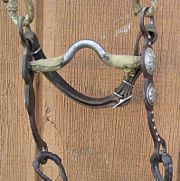
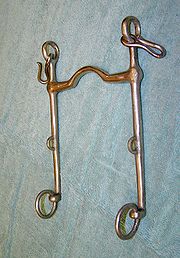
Bit (horse)
A bit is a type of horse tack used in equestrian activities, usually made of metal or a synthetic material, and is placed in the mouth of a horse or other equid and assists a rider in communicating with the animal. It rests on the bars of the mouth in an interdental region where there are no teeth...
used for riding
Equestrianism
Equestrianism more often known as riding, horseback riding or horse riding refers to the skill of riding, driving, or vaulting with horses...
horse
Horse
The horse is one of two extant subspecies of Equus ferus, or the wild horse. It is a single-hooved mammal belonging to the taxonomic family Equidae. The horse has evolved over the past 45 to 55 million years from a small multi-toed creature into the large, single-toed animal of today...
s that uses lever action. It includes the pelham bit
Pelham bit
A pelham bit is a type of bit used when riding a horse. It has elements of both a curb bit and a snaffle bit. In this respect a pelham bit functions similar to a double bridle, and like a double bridle it normally has "double" reins: a set of curb reins and a set of snaffle reins. Because it has...
and the Weymouth curb
Double bridle
A double bridle, also called a full bridle or Weymouth bridle, is a bridle that has two bits and four reins . One bit is the bradoon , is a modified snaffle bit that is smaller in diameter and has smaller bit rings than a traditional snaffle, and it is adjusted so that it sits above and behind the...
along with the traditional "curb bit" used mainly by Western riders
Western riding
Western riding is a style of horseback riding which evolved from the ranching and warfare traditions brought to the Americas by the Spanish Conquistadors, and both equipment and riding style evolved to meet the working needs of the cowboy in the American West...
.
Kimblewicks or "Kimberwickes" are modified curb bits, and a curb bit is used in a double bridle
Double bridle
A double bridle, also called a full bridle or Weymouth bridle, is a bridle that has two bits and four reins . One bit is the bradoon , is a modified snaffle bit that is smaller in diameter and has smaller bit rings than a traditional snaffle, and it is adjusted so that it sits above and behind the...
along with a bradoon. A curb bit is, in general, more severe than a basic snaffle bit, although there are several factors that are involved in determining a bit's severity. Liverpool bits are a type of curb bit commonly used for horses in harness.
The curb bit
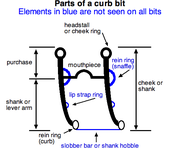
Curb chain
A curb chain, or curb strap, is a piece of horse tack used on any type of curb bit. It is a flat linked chain or strap that runs under the chin groove of the horse, between the bit shank purchase arms. It has a buckle or hook attachment and often has a "fly link" in the middle to apply a lip strap...
, and a shank, with one ring on each side of the purchase arm of the shank, and one ring on the bottom of the lever arm of the shank. Pelham bit
Pelham bit
A pelham bit is a type of bit used when riding a horse. It has elements of both a curb bit and a snaffle bit. In this respect a pelham bit functions similar to a double bridle, and like a double bridle it normally has "double" reins: a set of curb reins and a set of snaffle reins. Because it has...
s add a ring for a snaffle rein, next to the mouthpiece.
The action of the curb bit
A curb bit works on several parts of a horse's head and mouth. The bit mouthpieceBit mouthpiece
The mouthpiece is the part of a horse's bit that goes into the mouth of a horse, resting on the bars of the mouth in the sensitive interdental space where there are no teeth. The mouthpiece is possibly the most important determinant in the severity and action of the bit. Therefore, it should be...
acts on the bars, tongue and roof of the mouth. The shanks add leverage and place pressure on the poll via the crownpiece of the bridle
Bridle
A bridle is a piece of equipment used to direct a horse. As defined in the Oxford English Dictionary, the "bridle" includes both the headstall that holds a bit that goes in the mouth of a horse, and the reins that are attached to the bit....
, to the chin groove via the curb chain
Curb chain
A curb chain, or curb strap, is a piece of horse tack used on any type of curb bit. It is a flat linked chain or strap that runs under the chin groove of the horse, between the bit shank purchase arms. It has a buckle or hook attachment and often has a "fly link" in the middle to apply a lip strap...
, and, especially with a "loose jaw" shank, may act on the sides of the mouth and jaw.
The shank
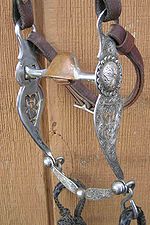
Snaffle
A snaffle bit is the most common type of bit used while riding horses. It consists of a bit mouthpiece with a ring on either side and acts with direct pressure. A bridle utilizing only a snaffle bit is often called a "snaffle bridle," particularly in the English riding disciplines...
bit, which applies direct rein pressure from the rider's hand to the horse's mouth, the curb can amplify rein pressure several times over, depending on the length of the curb's bit shank. Shank sizes vary from the Tom Thumb (2 inches long) to more than 5 inches. The longer the bit shank, the more powerful its potential effect on the horse. For this reason, overall shank or cheek length, from the top of the cheek ring to the bottom of the rein ring, usually cannot exceed 8½ inches for most horse show
Horse show
A Horse show is a judged exhibition of horses and ponies. Many different horse breeds and equestrian disciplines hold competitions worldwide, from local to the international levels. Most horse shows run from one to three days, sometimes longer for major, all-breed events or national and...
disciplines.
Leverage principles
The relation of the upper shank (purchase)—the shank length from the mouthpiece to the cheekpiece rings—and the lower shank or lever arm—the shank length from the mouthpiece to the lowest rein ring, is important in the severity of the bit. The standard curb bit has a 1½" cheek and a 4½" lower shank, thus producing a 1:3 ratio of cheek to lower shank, a 1:4 ratio of cheek to full shank, thus producing 3 lbs of pressure on the chin groove and 4 lbs of pressure on the horse's mouth for every 1 lb placed on the reins (3 and 4 newtons respectively for every newton).Regardless of the ratio, the longer the shank, the less force is needed on the reins to provide a given amount of pressure on the mouth. So, if one were to apply 1 lb of pressure on the horse's mouth, a 2" shank would need more rein pressure than an 8" shank to provide the same effect.
A long lower shank in relation to the upper shank (or purchase) increases the leverage, and thus the pressure, on the curb groove and the bars of the mouth. A long upper shank in relation to the lower shank increases the pressure on the poll, but does not apply as much pressure on the bars of the mouth.
However, longer-shanked bits must rotate back further before applying pressure on the horse's mouth than shorter-shanked bits. Therefore, the horse has more warning in a long-shanked bit, allowing it to respond before any significant pressure is applied to its mouth, than it would in a shorter-shanked bit. In this way, a longer shank can allow better communication between horse and rider, without increasing severity. This is also directly dependent on the tightness of the curb chain.
Types
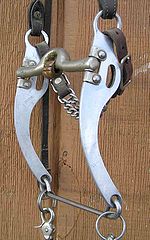
The cheek-shank angle also varies, with some straight up and down, others with the shanks curving backward, and some with an S-curve in the shank. The straighter the cheek-shank line is, the less signal is provided to the horse before the bit engages. Those that curve backward provide more of a signal to the horse. Therefore, the type of shank needs to be considered according to the use of the horse. Horses that maintain a more vertical head position, such as dressage
Dressage
Dressage is a competitive equestrian sport, defined by the International Equestrian Federation as "the highest expression of horse training." Competitions are held at all levels from amateur to the World Equestrian Games...
horses, generally use a curb bit with straight shanks. Those that have a nose-out head position when working, such as cutting and roping horses, more commonly use a curved shank.
Mouthpiece
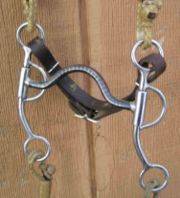
Bit mouthpiece
The mouthpiece is the part of a horse's bit that goes into the mouth of a horse, resting on the bars of the mouth in the sensitive interdental space where there are no teeth. The mouthpiece is possibly the most important determinant in the severity and action of the bit. Therefore, it should be...
controls the pressure on the tongue, roof of the mouth, and bars. A mullen mouth places even pressure on the bars and tongue. A port places more pressure on the bars, but provides room for the tongue. A high port may act on the roof of the mouth as it touches. Some western style curbs, particularly the Spade Bit
Spade bit
Spade bit may refer to:*Spade bit used on horses*Spade bit used on a drill...
, have both a straight bar mouthpiece and a high welded port., thus acting on the bars, tongue and palate. In the wrong hands, such bits can be extremely severe, but on an exquisitely trained animal, they allow the rider to communicate with the horse with a simple touch of the fingertips to the rein
Rein
Reins are items of horse tack, used to direct a horse or other animal used for riding or driving. Reins can be made of leather, nylon, metal, or other materials, and attach to a bridle via either its bit or its noseband.-Use for riding:...
s.
Curb bits can also be purchased with a variety of jointed mouthpieces that are sometimes mistakenly called "snaffles", some of which (like the twisted wire) can further increase severity. Jointed mouthpieces increase the pressure on the bars due to the nutcracker action of the mouthpiece. In addition, the joint angle is altered by the shank leverate to tip the bit downward and into the tongue. These bits, sometimes called "cowboy snaffles" due to their popularity among western riders
Western riding
Western riding is a style of horseback riding which evolved from the ranching and warfare traditions brought to the Americas by the Spanish Conquistadors, and both equipment and riding style evolved to meet the working needs of the cowboy in the American West...
, are actually more harsh than a curb with a simple, solid, ported mouthpiece.
Accessories

The curb chain
Curb chain
A curb chain, or curb strap, is a piece of horse tack used on any type of curb bit. It is a flat linked chain or strap that runs under the chin groove of the horse, between the bit shank purchase arms. It has a buckle or hook attachment and often has a "fly link" in the middle to apply a lip strap...
or strap applies pressure to the curb groove under a horse's chin. When the shank of the bit rotates back (due to rein pressure), the cheek of the bit rotate forward since it is a lever arm. The curb chain is attached to the rings at the end of the cheek. So as the cheek moves forward, it pulls the curb chain, tightening in the curb groove. Once it comes in contact with the curb groove of the horse it acts as a fulcrum, causing the cannons of the bit mouthpiece to push down onto the horse's bars, thus amplifing the bit's pressure on the bars of the horse's mouth.
The action of the bit is therefore also dependent on the tightness of the curb chain. If the bit is used without a curb chain (very uncommon-- and dangerous), it loses its leverage action. If used with a loose curb chain, it allows the shanks to rotate more before the curb chain is tight enough to act as a fulcrum and exert pressure. This extra rotation can warn the horse before pressure is exerted on the mouth, so the well-trained horse may respond faster. If used with a very tight curb chain, the bit immediately exerts leverage and increased pressure on the bars as soon as pressure is applied to the reins. Therefore, a tight curb chain is harsher, and provides less finesse in signaling the horse than a looser curb chain would.
Less often seen is the lip strap
Lip strap
A lip strap is a piece of horse tack used sometimes on some types of curb bit and Pelham bits. The lip strap runs between the bit shank lever arms and passes through a special center ring on a curb chain...
, a thin strap or light chain that helps keep the curb chain in place and also prevents the horse from grabbing, or "lipping" the bit shanks with its mouth.
Styles
Curb bits have tremendous variation, from the relatively simple English Weymouth curb or the simple western medium-port curb to very elaborate designs with complex mouthpieces and shank designs. Some of the more common include:- Weymouth or Weymouth curb: commonly used in a double bridleDouble bridleA double bridle, also called a full bridle or Weymouth bridle, is a bridle that has two bits and four reins . One bit is the bradoon , is a modified snaffle bit that is smaller in diameter and has smaller bit rings than a traditional snaffle, and it is adjusted so that it sits above and behind the...
. It is an EnglishEnglish ridingEnglish riding is a term used to describe a form of horse riding that is seen throughout the world. There are many variations in English riding, but all feature a flat English saddle without the deep seat, high cantle or saddle horn seen on a Western saddle nor the knee pads seen on an Australian...
style with a straight shank. The mouthpiece can be one of numerous styles, but usually it is solid, with a low port. - Grazing bit: A western curb with shanks turned back nearly 90 degrees, allegedly to allow the horse to graze while wearing a curb bit. Modern western bits with moderately curved or angled shanks are sometimes called grazing bits, even if the angle is less extreme than the original design.
- Spade bitSpade bit (horse)The spade bit is a historic vaquero design for a type of curb bit with straight, highly decorated shanks and a mouthpiece that includes a straight bar, a narrow port with a cricket, and a "spoon," a flat, partly rounded plate affixed above the port, supported by braces on either side...
: A historic vaqueroCowboyA cowboy is an animal herder who tends cattle on ranches in North America, traditionally on horseback, and often performs a multitude of other ranch-related tasks. The historic American cowboy of the late 19th century arose from the vaquero traditions of northern Mexico and became a figure of...
design with straight, highly decorated shanks and a mouthpiece that includes a straight bar, a narrow port with a cricket, and a "spoon," a flat, partly rounded plate affixed above the port, supported by braces on either side. Considered a highly technical piece of equipment to be used only on a finished horse. - Liverpool bit: A curb bit with several rein-attachment slots on the curb arms, giving a choice of leverage – the reins may alternatively be attached directly to the bit to use it as a simple snaffle. Used for horses in harness, especially when working in teams, when different horses may require different treatment – their bits can be adjusted so the same tension on the reins of each horse gives a similar result. This allows the reins of the different horses in a team to be joined together, minimising the number of reins the driver has to manage.
Fitting
Curbs are generally placed lower down in a horse's mouth than snaffleSnaffle
A snaffle bit is the most common type of bit used while riding horses. It consists of a bit mouthpiece with a ring on either side and acts with direct pressure. A bridle utilizing only a snaffle bit is often called a "snaffle bridle," particularly in the English riding disciplines...
bits, touching the corners of the mouth, or creating a single slight wrinkle in the lips. The lower the bit is placed, the more severe it is as the bars of the mouth get thinner and so pressure is more concentrated.
The curb chain
Curb chain
A curb chain, or curb strap, is a piece of horse tack used on any type of curb bit. It is a flat linked chain or strap that runs under the chin groove of the horse, between the bit shank purchase arms. It has a buckle or hook attachment and often has a "fly link" in the middle to apply a lip strap...
should be adjusted correctly, lying flat against the chin groove and only coming into action against the jaw when the shank is rotated, but not so loose that the shank exceeds 45 degrees of rotation.

